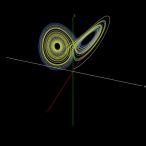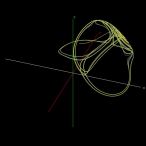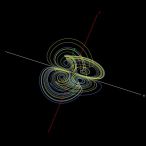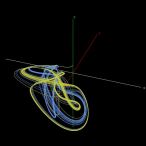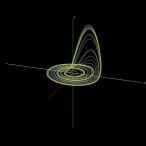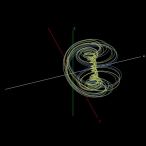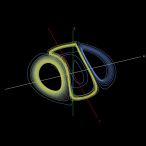Differential Equations : Plotting Trajectory of Solutions with 3D
Simplified Explanation
This tool draws solution trajectories of 3-dimensional differential equations. While there are equations that draw mysterious trajectories even in 2D, in 3D, seemingly simple equations can produce chaotic solution trajectories depending on specific parameters and initial values. These equations exhibit bounded yet whimsical trajectories. I searched online and gathered equations with intriguing properties. The drawing of solution trajectories is approximated using the 4th Order Runge-Kutta method. Two points are specified as initial values, and the trajectories evolving over time are dynamically plotted.
After drawing, you can observe the solution trajectories from various angles by changing the Angle and Vertical Axis.
I'd like to provide a brief explanation according to the titles displayed in the dropdown box. However, I lack the knowledge for such explanations, so I'll simply provide brief comments and URLs of the sites where the equations are introduced.
I first encountered the Lorenz model in the late 1980s when chaos and fractals were popular. I remember extending the programming source included in Mitsuo Morimoto's "Differential Equations Using Computers to 3D and drawing the solution trajectory of the Lorenz model.
The Lorenz model gained fame due to the butterfly effect, where slight variations in initial values, despite being bounded, result in completely unforeseen trajectories. Recently, NHK(the public broadcasting in Japan) has been excessively citing the "butterfly effect"... :-(
You can find plenty of hits if you search for the Lorenz model. For reference, I'll mention the following site.
The parameters often used are $a = 10.0, b = 28.0, c = 8.0 / 3.0$. This tool also uses these values by default. Initial values are set as $(0, 1, 2)$ and $(0, 1, 2.01)$.
While it's hard to believe this equation leads to chaos, it indeed does.
For the Thomas model, please refer to the following site.
1. Thomas' cyclically symmetric attractor
In this tool, the parameters are $a = 0.208186$, and initial values are $(0, 1, 2)$ and $(0, 1, 2.01)$.
The trajectory drawn resembles a combination of two Lorenz system. Although it's based on the first site I found introducing this equation, it slightly differs from the Four-Wing equation presented on other sites. However, when actually plotted, it indeed resembles Four-Wing. Lorenz systemが2つ合体したような軌道が描かれます。
For information about Four-Wing, the following site was the first one I found.
The tool uses parameters $a = 0.2$, $b = 0.01$, $c= -0.4$, and initial values $(x, y, z) = (0, 1, 2)$ and $(0, 1, 2.01)$.
Similar to the Thomas model, this equation undergoes quite regular changes but eventually leads to chaos.
For information about the Halvorsen system, please refer to the following site.
In this tool, the parameter is $a = 1.499$, and initial values are $(x, y, z) = (0, 1, 2)$ and $(0, 1, 2.01)$.
Similar to the Thomas model, this equation exhibits fairly regular changes yet leads to chaos.
For information about the Rössler system, please refer to the following site.
The tool uses parameters $a = 0.2$, $b = 0.2$, $c= 5.7$, and initial values $(x, y, z) = (0, 1, 2)$ and $(0, 1, 2.01)$.
It seems to produce chaotic solutions, but I don't observe sensitivity to initial values.
For information about the Sprott system, please refer to the following site.
The tool uses parameters $a = 2.07$, $b = 1.79$ and initial values $(x, y, z) = (0.63, 0.47, -0.54)$ and $(0.63, 0.47, -.055)$.
The solution trajectory moves complexly among three attractors. Similar to the Lorenz model, sensitivity to initial values is observed.
For information about the Rabinovich-Fabrikant system, please refer to the following site.
1. Rabinovich–Fabrikant equations
The tool uses parameters $a = 0.14$, $b = 0.1$ and initial values $(x, y, z) = (-1, 0.9, 0.6)$ and $(-1, 0.9, 0.60001)$.


